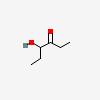4-Hydroxyhexan-3-one
- 4-Hydroxyhexan-3-one
- Propioin
- 4-Hydroxy-3-hexanone
- 4984-85-4
- Propionoin
- Create:2004-09-16
- Modify:2025-01-11

- 4-hydroxy-3-hexanone
- propioin
- 4-Hydroxyhexan-3-one
- Propioin
- 4-Hydroxy-3-hexanone
- 4984-85-4
- Propionoin
- 3-Hexanone, 4-hydroxy-
- 3-Hydroxyhexan-4-one
- RB7X233LSR
- 3-Hydroxy-4-hexanone
- EINECS 225-637-3
- NSC-23087
- AI3-13026
- CHEBI:18351
- SKCYVGUCBRYGTE-UHFFFAOYSA-
- DTXSID40863474
- Ethyl .alpha.-hydroxypropyl ketone
- NSC 23087
- (+/-)-4-HYDROXY-3-HEXANONE
- MFCD00043572
- -Hexanone, 4-hydroxy-
- UNII-RB7X233LSR
- SCHEMBL108041
- DTXCID10812090
- 4-Hydroxy-3-hexanone, AldrichCPR
- NSC23087
- LMFA12000029
- AKOS006228413
- SB83904
- 11046-98-3
- AS-81700
- NS00045061
- P0974
- C02948
- D92050
- Q27103019
- 52217-03-5
59 99.99
31 55.56
57 40.79
29 37.46
41 23.89
59 999
31 556
57 408
29 375
41 239


H226 (100%): Flammable liquid and vapor [Warning Flammable liquids]
H302+H312+H332 (97.4%): Harmful if swallowed, in contact with skin or if inhaled [Warning Acute toxicity, oral; acute toxicity, dermal; acute toxicity, inhalation]
H302 (97.4%): Harmful if swallowed [Warning Acute toxicity, oral]
H312 (97.4%): Harmful in contact with skin [Warning Acute toxicity, dermal]
H332 (97.4%): Harmful if inhaled [Warning Acute toxicity, inhalation]
P210, P233, P240, P241, P242, P243, P261, P264, P270, P271, P280, P301+P317, P302+P352, P303+P361+P353, P304+P340, P317, P321, P330, P362+P364, P370+P378, P403+P235, and P501
(The corresponding statement to each P-code can be found at the GHS Classification page.)
Aggregated GHS information provided per 39 reports by companies from 2 notifications to the ECHA C&L Inventory. Each notification may be associated with multiple companies.
Information may vary between notifications depending on impurities, additives, and other factors. The percentage value in parenthesis indicates the notified classification ratio from companies that provide hazard codes. Only hazard codes with percentage values above 10% are shown.
Flam. Liq. 3 (100%)
Acute Tox. 4 (97.4%)
Acute Tox. 4 (97.4%)
Acute Tox. 4 (97.4%)
Patents are available for this chemical structure:
https://patentscope.wipo.int/search/en/result.jsf?inchikey=SKCYVGUCBRYGTE-UHFFFAOYSA-N
- CAS Common ChemistryLICENSEThe data from CAS Common Chemistry is provided under a CC-BY-NC 4.0 license, unless otherwise stated.https://creativecommons.org/licenses/by-nc/4.0/4-Hydroxy-3-hexanonehttps://commonchemistry.cas.org/detail?cas_rn=4984-85-4
- ChemIDplusChemIDplus Chemical Information Classificationhttps://pubchem.ncbi.nlm.nih.gov/source/ChemIDplus
- DTP/NCILICENSEUnless otherwise indicated, all text within NCI products is free of copyright and may be reused without our permission. Credit the National Cancer Institute as the source.https://www.cancer.gov/policies/copyright-reuse
- EPA DSSTox4-Hydroxyhexan-3-onehttps://comptox.epa.gov/dashboard/DTXSID40863474CompTox Chemicals Dashboard Chemical Listshttps://comptox.epa.gov/dashboard/chemical-lists/
- European Chemicals Agency (ECHA)LICENSEUse of the information, documents and data from the ECHA website is subject to the terms and conditions of this Legal Notice, and subject to other binding limitations provided for under applicable law, the information, documents and data made available on the ECHA website may be reproduced, distributed and/or used, totally or in part, for non-commercial purposes provided that ECHA is acknowledged as the source: "Source: European Chemicals Agency, http://echa.europa.eu/". Such acknowledgement must be included in each copy of the material. ECHA permits and encourages organisations and individuals to create links to the ECHA website under the following cumulative conditions: Links can only be made to webpages that provide a link to the Legal Notice page.https://echa.europa.eu/web/guest/legal-notice4-hydroxyhexan-3-onehttps://echa.europa.eu/substance-information/-/substanceinfo/100.023.3074-hydroxyhexan-3-one (EC: 225-637-3)https://echa.europa.eu/information-on-chemicals/cl-inventory-database/-/discli/details/93856
- FDA Global Substance Registration System (GSRS)LICENSEUnless otherwise noted, the contents of the FDA website (www.fda.gov), both text and graphics, are not copyrighted. They are in the public domain and may be republished, reprinted and otherwise used freely by anyone without the need to obtain permission from FDA. Credit to the U.S. Food and Drug Administration as the source is appreciated but not required.https://www.fda.gov/about-fda/about-website/website-policies#linking4-HYDROXYHEXAN-3-ONEhttps://gsrs.ncats.nih.gov/ginas/app/beta/substances/RB7X233LSR
- New Zealand Environmental Protection Authority (EPA)LICENSEThis work is licensed under the Creative Commons Attribution-ShareAlike 4.0 International licence.https://www.epa.govt.nz/about-this-site/general-copyright-statement/
- ChEBI4-hydroxyhexan-3-onehttps://www.ebi.ac.uk/chebi/searchId.do?chebiId=CHEBI:18351
- Yeast Metabolome Database (YMDB)4-hydroxyhexan-3-onehttps://www.ymdb.ca/compounds/YMDB00804
- Comparative Toxicogenomics Database (CTD)LICENSEIt is to be used only for research and educational purposes. Any reproduction or use for commercial purpose is prohibited without the prior express written permission of NC State University.http://ctdbase.org/about/legal.jsp
- EPA Chemical and Products Database (CPDat)4-Hydroxyhexan-3-onehttps://comptox.epa.gov/dashboard/DTXSID40863474#exposureEPA CPDat Classificationhttps://www.epa.gov/chemical-research/chemical-and-products-database-cpdat
- EU Food Improvement Agents4-Hydroxyhexan-3-onehttps://eur-lex.europa.eu/legal-content/EN/TXT/?uri=CELEX:32012R0872
- Japan Chemical Substance Dictionary (Nikkaji)
- KEGGLICENSEAcademic users may freely use the KEGG website. Non-academic use of KEGG generally requires a commercial licensehttps://www.kegg.jp/kegg/legal.html
- LIPID MAPS4-Hydroxyhexan-3-onehttps://lipidmaps.org/databases/lmsd/LMFA12000029Lipid Classificationhttps://www.lipidmaps.org/
- MassBank Europe4-HYDROXY-3-HEXANONEhttps://massbank.eu/MassBank/Result.jsp?inchikey=SKCYVGUCBRYGTE-UHFFFAOYSA-N
- MassBank of North America (MoNA)LICENSEThe content of the MoNA database is licensed under CC BY 4.0.https://mona.fiehnlab.ucdavis.edu/documentation/license
- NIST Mass Spectrometry Data CenterLICENSEData covered by the Standard Reference Data Act of 1968 as amended.https://www.nist.gov/srd/public-law4-Hydroxy-3-hexanonehttp://www.nist.gov/srd/nist1a.cfm
- SpectraBase4-Hydroxy-3-hexanonehttps://spectrabase.com/spectrum/BqUormi1Geb3-Hexanone, 4-hydroxy-https://spectrabase.com/spectrum/HU6e7evcYXU4-HYDROXY-3-HEXANONEhttps://spectrabase.com/spectrum/G4XaWaZ1TLA4-hydroxy-3-hexanonehttps://spectrabase.com/spectrum/Bjk7CJtRwNn4-HYDROXY-3-HEXANONEhttps://spectrabase.com/spectrum/I3ipu222zPX3-HEXANONE, 4-HYDROXY-,https://spectrabase.com/spectrum/ExsjD9M1GVR
- Metabolomics Workbench4-Hydroxyhexan-3-onehttps://www.metabolomicsworkbench.org/data/StructureData.php?RegNo=5435
- NMRShiftDB
- Rhea - Annotated Reactions DatabaseLICENSERhea has chosen to apply the Creative Commons Attribution License (http://creativecommons.org/licenses/by/4.0/). This means that you are free to copy, distribute, display and make commercial use of the database in all legislations, provided you credit (cite) Rhea.https://www.rhea-db.org/help/license-disclaimer
- Springer Nature
- Thieme ChemistryLICENSEThe Thieme Chemistry contribution within PubChem is provided under a CC-BY-NC-ND 4.0 license, unless otherwise stated.https://creativecommons.org/licenses/by-nc-nd/4.0/
- Wikidata4-hydroxyhexan-3-onehttps://www.wikidata.org/wiki/Q27103019
- PubChem
- Medical Subject Headings (MeSH)LICENSEWorks produced by the U.S. government are not subject to copyright protection in the United States. Any such works found on National Library of Medicine (NLM) Web sites may be freely used or reproduced without permission in the U.S.https://www.nlm.nih.gov/copyright.html
- GHS Classification (UNECE)GHS Classification Treehttp://www.unece.org/trans/danger/publi/ghs/ghs_welcome_e.html
- NORMAN Suspect List ExchangeLICENSEData: CC-BY 4.0; Code (hosted by ECI, LCSB): Artistic-2.0https://creativecommons.org/licenses/by/4.0/NORMAN Suspect List Exchange Classificationhttps://www.norman-network.com/nds/SLE/
- MolGenieMolGenie Organic Chemistry Ontologyhttps://github.com/MolGenie/ontology/
- PATENTSCOPE (WIPO)SID 388458959https://pubchem.ncbi.nlm.nih.gov/substance/388458959
- NCBI



